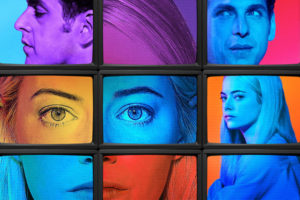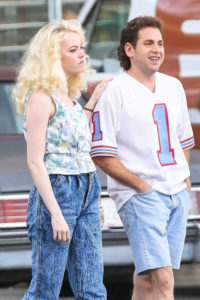If you’re looking for a platonic tryst with a Netflix mini-series, try MANIAC. You may have already sampled it (since its premier on Sept. 21, 2018) and found it slow in the beginning episodes. This gradual unfolding is by design. From the get-go episode “The Chosen One,” MANIAC doesn’t seek to thrill, scare, or romance. The show just wants to be friends.
To use Aldous Huxley’s term, we are each “island universes.” And this state of disconnect with potential is early MANIAC in a nutshell. Friendships take time and the mini-series takes its time to establish an almost-reality setting, the tension of its disconnect / connect theme, and its complex central characters. The schizophrenic Owen Milgrim. The anti-social Annie Landsberg.
All said, this sci-fi drama-comedy is more satisfying than any TV I’ve seen in a while. I watched MANIAC twice through. And thought twice, even enjoyed the dense first episode much more the second time.
Created by Patrick Somerville and Cary Joji Fukunaga, the ten-episode series follows Annie (Emma Stone) and Owen (Jonah Hill). Miserable strangers until they meet through a high-risk experimental drug trial. Through the trial the protagonists experience a complex mixture of biographical and genre-hopping hallucinations.
THE EARLY GROUNDWORK
Inspired by a Norwegian television series of the same title, MANIAC runs well off the map of our small-screen expectations. The pill and computer-generated trips would feel empty—sometimes silly— were it not for the early groundwork.
A voice-over in the show’s early minutes offers a hypothesis. “All the worlds that almost were matter just as much as the world we’re in.”
Just as were hearing this, Annie sees some office-building junk put out on the sidewalk. She picks out a Rubik’s Cube and tosses it behind her. Then selects another synchronistic object, a copy of Cervantes’ Don Quixote. She keeps it because her sister read the huge novel as an adolescent. Then Annie has a back-and-forth with a security guard, an exchange destined to reoccur.
Finally Owen, still unknown to Annie, enters the picture. Walking behind her, he is easy to miss if our focus is simply on Annie. Owen picks up the Rubik’s Cube and goes into the building of Milgrim Enterprises, his family’s place of business. They pass close but unnoticed, their meeting and the plot postponed for detail. For the visual stimulus to widen our focus.
RICH WITH THINGINESS
With these two marvelous props, a book and a puzzle, an unknowing baton has been passed. One that will have ramifications in “saving a world.” If not the world. But first we are asked to inspect what we see. To view the screen as if were are embarking on a psychedelic trip of our own.
Later in “The Chosen One” Annie is sitting in a coffee shop near her apartment in Brooklyn. She notices a man in the shop seated in the middle of a group telling a story. It turns out he’s trying to engage with strangers who choose to ignore him, first to his right and then to his left. Annie sees this and then averts her eyes just as their gazes are about to meet.
She has witnessed this man’s humiliating isolation. His failure to connect. Moreover, screenwriter and director have further demonstrated their bent for a wider focus. A focus with significant objects and key interactions potentially anywhere.
THE “ALMOST WORLD” OF MANIAC
Annie and Owen have chronic sibling angst. Their abnormal personalities and character scenarios make them engrossing subjects for the Neberdine Pharmaceutical and Biotech trial. While we’re getting to know them, the alternative reality of MANIAC has to be shown. The home base of the story is like New York City. But with important differences.
For example in New York Harbor, there is a Statue of Extra Liberty. A winged icon of shiny chrome and vague gender. Owen and Annie’s world of “Extra Liberty,” however, comes across as more oppressive than our own. Apparently an extra liberty is not having to pick up after your dog. There are civic turd retrievers that look like mini tanks that do the job.
(As it turns out the mini tanks are a product manufactured by Owen’s industrialist family, Milgrim Enterprises—see the thrillist.com for more Easter Eggs,)
The style of the dog-doo disposing tanks resemble the machinery of the Star Wars universe. As does the sensory-deprivation tank, known as an A-Void pod. It’s in an A-Void pod that Annie’s dad, Hank, wallows away the hours in his backyard as casually as if on a lawn chair. Hank Landsberg (played by Hank Azaria) has long been grieving over the family’s abandonment by his wife and the tragic loss of his daughter. Annie’s revered younger sister.
These rather forlorn technologies hint at the lack of intimacy in MANIAC’s world.
CORPORATE SERVICES FOR THE LONESOME
But what really hammers home the thematic disconnect are the corporate services for the lonely. There is Friend Proxy for people who want to have a scene with a surrogate rather than an actual friend. There’s Temp Husband for widows. And most importantly for Owen’s storyline, there is Ad Buddy.
Each of these services feels eerily familiar, like forlorn next-wave relatives of social media and online dating. Ad Buddy is one-on-one advertising, a sales-pitcher going over ads in a binder to a customer who gets paid to listen to the ads. After declining to sign up for Temp Husband, Owen turns to the NPB drug trial that he learns of through Ad Buddy.
Annie’s route to the trial is more complicated. Among other things it involves her faking at being a proxy for a Proxy Friend appointment. A scene that underlines her absurdist desperation.
Through the course of this ten episode series Annie and Owen discover that they are uniquely qualified to be more than corporate service friends. Or co-drug trial participants. They become actual buddies.
THE ACTING OF MANIAC IS SUPERB
The acting of Emma Stone and Jonah Hill is terrific. Especially for the like-ability they bring to their roles. And for the complexity they bring to the altered realities in which they are always both different and the same. Liking Annie and Owen as they experience the trips of the “A,” “B,” and “C” pills is critical. Otherwise the hallucinatory flashbacks, flash-sideways, and flash-forwards would crash.
Billy Magnussen turns in a pair of strong performances. One as Owen’s horrible brother, Jed Milgrim, indicted for sexual misconduct. The other as the imaginary brother of Owen’s schizophrenic lapses, Grimsson. Periodically Grimsson appears to remind Owen, “The pattern is the pattern.”
In the first episode it is Grimsson that tells Owen to watch out for a woman—he’ll know her when he sees her—who will be the agent with the plan to save the world. Justin Theroux as Dr. James Mantleray and Sonoya Mizuno as Dr Azumi Fujita give their scientist characters just enough odd rigidity to contrast with the subjects of the trial.
Sally Field plays dual roles of Dr. Greta Mantleray, pop-therapist, and GRTA, the personality-driven super computer controlling the NPB experiment. She does this with aplomb, even pulling off a scene in which her two characters face off.
Another stand-out performance from a scientist character comes from Rome Kanda as Dr. Robert Muramoto who perfectly blends zany and serious.
YEAH, ROTE ACTION
MANIAC has its share of obligatory or rote action. And campy detours. One a Raymond Chandler-like noir heist scenario for the lost 53rd chapter of Don Quixote (5, “Exactly Like You”). Another an international spy thriller with an alien celebrity named Ernie (9, Utangatta). And there’s a journey of elves to the Lake of Clouds (8, “The Lake of the Clouds”).
All of these place shifts with dubious agendas would fall flat were it not for the effective characterizations.
KEY MOMENTS CARRY THE WILD PLOT
A favorite moment for me—when acting, directing, and writing all work perfectly together—is in “Furs by Sebastian.” Owen wakes up in front of a television in a Long Island home. He is now Bruce, a Long Island husband and father of two, who hears his wife in the kitchen. She is telling him not to fall asleep in front of the TV. Bruce walks into the kitchen—wearing a football jersey with MOON on the back—to discover his wife Linda doing dishes.
Linda is Annie with super-frilly 80s blonde hair. The SUN to his MOON. The look on her face as she turns from the sink to goad him into action is just right. She shows him some left-over pasta at the bottom of a pot. She asks, “Keep or Toss?” Then answers her own question with perfect domestic hostility, “Keep!”
Later, during their caper to get back a stolen lemur before the villain furrier Sebastian can turn it into a hat, Linda will wonder what Bruce thinks of her. He says, “You’re a force of nature.” Which is a perfect reminder of the series Cosmos-like prologue. It’s explanation of the universe as matter and energy, with all objects in nature seeking connection.
Underlying the theme of connection is the use of the same actor (Joseph Sikora) that was the ignored talking man in “The Chosen One” to play Sebastian’s dorky fitness instructor son, J.C., in this, the fourth episode.
WHAT ABOUT MARRIAGE?
Interestingly, marriage doesn’t play out well for Owen in any of his various guises. The implication is that his character is after a more innocent connection. At least one that doesn’t come with a contract. His wealthy parents even hire a woman to romance and to marry him.
Another favorite moment (Also in “The Chosen One”) is when Owen offers up his escape fantasy to his brother Jed’s fiancé, Adelaide. Owen and Adelaide (Jemima Kirk) share the anxiety of their connections to the unstable Jed Milgrim. They both know he is guilty of sexual bullying at the workplace. Owen suggests she raid his bank account and they run off, far far away, change their identities, and live different lives.
For him the quixotic fantasy is almost real, but it cools off when Adelaide asks, “Are we a married couple?” He answers that they could be like brother and sisters. Or even friends.
10 EPISODES OF MATTER AND ENERGY
Not only are the characters Annie and Owen seeking connection and a way out of the psychic and actual prison of their lives, we the audience are asked to make connections. Our connections come from careful viewing for the surprise reoccurrences of people and objects, repurposed but somehow the same as where we left them.
The Lake of the Clouds Motel in the second episode “Windmills” becomes the mystical destination in the fantasy/elf sequence “The Lake of the Clouds.” Both these places are important for Annie and her quest to be with and to heal from the tragic loss of her sister Ellie (Julia Garner).
MANIAC is dense with semiotic detail. The writers and director take full advantage of the freedom that comes with a ten-episode series. The show asks of us that we consider the parts. And give the fragments of MANIAC’s world and its hallucinatory almost-worlds our undivided attention. MANIAC asks that we get beyond story motion and violent conflict to something more diverse, non-linear, and profound. Connect the dots. Joust with windmills.
HAWKS GERBILS ALIENS
In Milgrim family lore, Owen as a child rescued a hawk with a broken wing, which became well enough to eat his brother Jed’s gerbil named Ernie. In another episode Owen becomes a hawk in Annie’s fantasy/elf world. Later Ernie is the name of the celebrity alien who would have announced his presence to our world if not for his accidental electrocution. From the gimlet-drenched sound system. The spilt gimlet is the goof of Owen’s Icelandic spy character, Snorri.
The silly, the serious, the slick, and the sentimental all join hands in this visually hypnotic, surprising and satisfying psychic adventure. All is not random. The pattern is the pattern.




MANIAC is a gorgeously filmed mosaic. The obsession with the parts reveals a creative team’s belief in the whole.
Cool comment, scooter. Thanks!